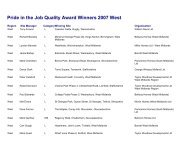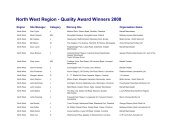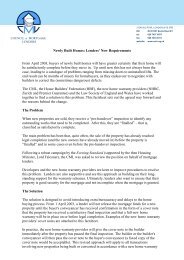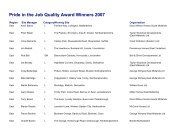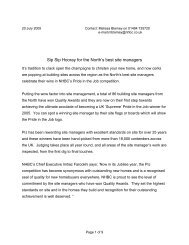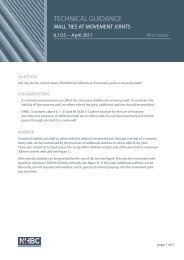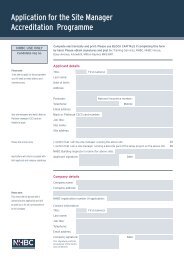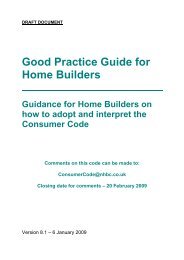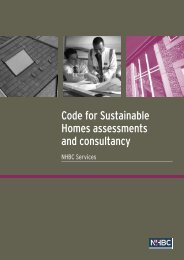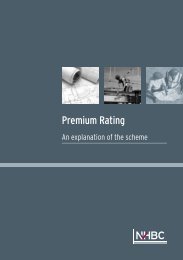June 2010 - NHBC Home
June 2010 - NHBC Home
June 2010 - NHBC Home
You also want an ePaper? Increase the reach of your titles
YUMPU automatically turns print PDFs into web optimized ePapers that Google loves.
Issue 47<br />
<strong>June</strong> <strong>2010</strong><br />
Contaminated Land - New Soil Guideline Values<br />
Soil Guideline Values (SGV’s) were<br />
originally introduced by DEFRA<br />
in March 2002 for a range of<br />
contaminants that may be found in<br />
the ground on brownfield land or<br />
previously developed sites. The SGV’s<br />
were specifically developed for use<br />
in assessing the risk to human health<br />
from contamination in soils as part<br />
of the Contaminated Land Exposure<br />
Assessment (CLEA) framework for<br />
use in the UK.<br />
The CLEA framework and SGV’s were<br />
developed to provide authoritative<br />
guidance in support of the<br />
implementation of Part 2A of the<br />
Environmental Protection Act 1990<br />
that laid down the new regulatory<br />
role for Local Authorities dealing<br />
with land contaminated and also to<br />
provide a more robust and scientific<br />
method of assessment to replace<br />
the previous guidance: 1987 ICRCL<br />
(Interdepartmental Committee on<br />
the Redevelopment of Contaminated<br />
Land) recommendations for action and<br />
trigger levels for contaminants in soils.<br />
However, since the original publication<br />
in 2002 further detailed scientific<br />
reviews together with extensive<br />
consultations with stakeholders in<br />
the contaminated land industry have<br />
resulted in a number of fundamental<br />
revisions to the contaminated land<br />
framework and the model known as<br />
CLEA UK used to produce SGV’s.<br />
As a result, in July 2008, the 2002<br />
SGV’s were withdrawn as they no<br />
longer reflected the updated UK<br />
approach to human health risk<br />
assessments.<br />
From late spring 2009, new SGV’s<br />
have been produced and published<br />
for a variety of contaminants using an<br />
updated framework and model now<br />
known as CLEA 1.06. These revised<br />
SGV’s are recognised in the UK as<br />
being authoritative and scientific. They<br />
should be used as a tool to aid the<br />
evaluation of whether a concentration<br />
of a contaminant in near surface soils is<br />
‘acceptable’ in the assessment of long<br />
term risks to human health for various<br />
land uses including residential.<br />
SGV’s are intended only to assess<br />
long term risks to human health from<br />
contaminants in soils and they do not<br />
take into account other issues such as:<br />
• Risks for short term exposure<br />
• Other types of risk to humans, such<br />
as fire, suffocation and explosion<br />
• Non-human receptors, for instance<br />
ecological, controlled waters,<br />
property, domestic produce or<br />
domestic pets<br />
• Contaminant sources arising from<br />
and to controlled waters (ground<br />
water)<br />
• Free phase products in soils or<br />
groundwater beneath the site (e.g.<br />
hydrocarbons such as oils, diesel,<br />
petrol).<br />
DEFRA has an ongoing programme<br />
for publishing SGV’s for potential<br />
contaminants in soils and during<br />
2009 values have been released<br />
for the following; Benzene, Toluene,<br />
Ethylbenzane, Xylene (Hydrocarbon),<br />
ACTION<br />
Mercury, Selenium, Arsenic, Nickel,<br />
Phenol, Cadmium and Dioxin’s including<br />
PCB’s.<br />
When assessing contamination<br />
on a site, representative site soil<br />
concentrations at or below an SGV<br />
indicate that it is unlikely that there<br />
is a significant possibility of harm<br />
to human health and the site can be<br />
considered safe for development. When<br />
concentrations exceed an SGV, there<br />
may be a potential risk to human health<br />
and further risk assessment is required<br />
to determine whether remediation is<br />
necessary.<br />
Due to the complex nature of contamination, it is recommended by<br />
the <strong>NHBC</strong> that a suitably qualified person/consultant should always<br />
be used to investigate the site, assess the risks and develop any<br />
remediation strategy as necessary.<br />
9



